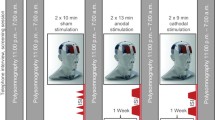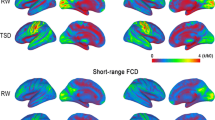Abstract
The pathophysiology of adult sleepwalking is still poorly understood. However, it is widely accepted that sleepwalking is a disorder of arousal. Arousal circuits widely project to the cortex, including motor cortex. We hypothesized that functional abnormality of these circuits could lead to changes in cortical excitability in sleepwalkers, even during wakefulness. We used transcranial magnetic stimulation (TMS) to examine the excitability of the human motor cortex during wakefulness in a group of adult sleepwalkers. When compared with the healthy control group, short interval intracortical inhibition (SICI), cortical silent period (CSP) duration, and short latency afferent inhibition (SAI) were reduced in adult sleepwalkers during wakefulness. Mean CSP duration was shorter in patients than in controls (80.9 ± 41 ms vs. 139.4 ± 37 ms; p = 0.0040). Mean SICI was significantly reduced in patients than in controls (73.5 ± 38.4% vs. 36.7 ± 13.1%; p = 0.0061). Mean SAI was also significantly reduced in patients than in controls (65.8 ± 14.2% vs. 42.8 ± 16.9%; p = 0.0053). This neurophysiological study suggests that there are alterations in sleepwalkers consistent with an impaired efficiency of inhibitory circuits during wakefulness. This inhibitory impairment could represent the neurophysiological correlate of brain “abnormalities” of sleepwalkers like “immaturity” of some neural circuits, synapses, or receptors.
Similar content being viewed by others
References
International Classification of Sleep Disorders (2005) Diagnostic and coding manual, revised. American Academy of Sleep Medicine, Rochester, MN
Gaudreau H, Joncas S, Zadra A, Montplaisir J (2000) Dynamics of slowwave activity during the NREM sleep of sleepwalkers and control subjects. Sleep 23(6):755–60
Jones BE (2003) Arousal systems. Front Biosci 8:s438–51
Bassetti C, Vella S, Donati F, Wielepp P, Weder B (2000) SPECT during sleepwalking. Lancet 356(9228):484–85
Hallett M (2000) Transcranial magnetic stimulation and the human brain. Nature 406:147–50
Ziemann U, Lonnecker S, Steinhoff BJ, Paulus W (1996) Effects of antiepileptics drugs on motor cortex excitability in humans: a transcranial magnetic stimulation study. Ann Neurol 40:367–78
Rossini PM, Barker AT, Berardelli A, Caramia MD, Caruso G, Cracco RQ, Dimitrijevic MR, Hallett M, Katayama Y, Lucking CH (1994) Noninvasive electrical and magnetic stimulation of the brain, spinal cord and roots: basic principles and procedures for routine clinical application Report of an IFCN committee. Electroencephalogr Clin Neurophysiol 91:79–2
Kujirai T, Caramia MD, Rothwell JC, Day BL, Thompson PD, Ferbert A, Wroe S, Asselman P, Marsden CD (1993) Corticocortical inhibition in human motor cortex. J Physiol 471:501–19
Ziemann U, Chen R, Cohen LG, Hallett M (1998) Dextromethorphan decreases the excitability of the human motor cortex. Neurology 51:1320–324
Di Lazzaro V, Oliviero A, Profice P, Pennisi MA, Di Giovanni S, Zito G, Tonali P, Rothwell JC (2000) Muscarinic receptor blockade has differential effects on the excitability of intracortical circuits in the human motor cortex. Exp Brain Res 135:455–61
Oliviero A, Molina-Leon A, Holler I, Florensa-Vila J, Siebner HR, Della Marca G, Di Lazzaro V, Teijeira-Alvarez J (2005) Reduced sensorimotor inhibition in the ipsilesional motor cortex in a patient with chronic stroke of the paramedian thalamus. Clinical Neurophysiol. 116(11):2592–598
Di Lazzaro V, Oliviero A, Meglio M, Cioni B, Tamburrini G, Tonali P, Rothwell JC (2000) Direct demonstration of the effect of lorazepam on the excitability of the human motor cortex. Clin Neurophysiol 111:794–99
Werhahn KJ, Kunesch E, Noachtar S, Benecke R, Classen J (1999) Differential effects on motorcortical inhibition induced by blockade of GABA uptake in humans. J Physiol 517(Pt 2):591–97
Sanger TD, Garg RR, Chen R (2001) Interactions between two different inhibitory systems in the human motor cortex. J Physiol 530:307–17
Di Lazzaro V, Oliviero A, Tonali PA, Marra C, Daniele A, Profice P, Saturno E, Pilato F, Masullo C, Rothwell JC (2002) Noninvasive in vivo assessment of cholinergic cortical circuits in AD using transcranial magnetic stimulation. Neurology 59(3):392–97
Timofeev I, Grenier F, Steriade M (2001) Disfacilitation and active inhibition in the neocortex during the natural sleep-wake cycle: an intracellular study. PNAS 98:1924–929
Salih F, Khatami R, Steinheimer S, Hummel O, Kuhn A, Grosse P (2005) Inhibitory and excitatory intracortical circuits across the human sleep-wake cycle using paired-pulse TMS. J Physiol 565:695–01
Sohn YH, Wiltz K, Hallett M (2002). Effect of volitional inhibition on cortical inhibitory mechanisms. J Neurophysiol 88(1):333–38
Jasper HH, Tessier J (1971) Acetylcholine liberation from cerebral cortex during paradoxical (REM) sleep. Science 172(983):601–02
Steriade M (2004) Acetylcholine systems and rhythmic activities during the waking-sleep cycle. Prog Brain Res. 145:179–96
Bliwise DL (2004) Sleep disorders in Alzheimer's disease and other dementias. Clin Cornerstone 6(Suppl 1A):S16–8
Di Lazzaro V, Oliviero A, Saturno E, Dileone M, Pilato F, Nardone R, Ranieri F, Musumeci G, Fiorilla T, Tonali P (2005) Effects of lorazepam on short latency afferent inhibition and short latency intracortical inhibition in humans. J Physiol 564(Pt 2):661–68
Di Lazzaro V, Pilato F, Dileone M, Tonali PA, Ziemann U (2005) Dissociated effects of diazepam and lorazepam on short-latency afferent inhibition. J Physiol 569(Pt 1):315–23
Chugani DC, Muzik O, Juhasz C, Janisse JJ, Ager J, Chugani HT (2001) Postnatal maturation of human GABAA receptors measured with positron emission tomography. Ann Neurol 49(5):618–26
Hutcheon B, Morley P, Poulter MO (2000) Developmental change in GABAA receptor desensitization kinetics and its role in synapse function in rat cortical neurons. J Physiol 522:3–7
Civardi C, Boccagni C, Vicentini R, Bolamperti L, Tarletti R, Varrasi C, Monaco F, Cantello R (2001) Cortical excitability and sleep deprivation: a transcranial magnetic stimulation study. J Neurol Neurosurg Psychiatry 71(6):809–12
Ziemann U, Tergau F, Bruns D, Baudewig J, Paulus W (1997) Changes in human motor cortex excitability induced by dopaminergic and antidopaminergic drugs. Electroencephalogr Clin Neurophysiol 105(6):430–37
Charney DS, Kales A, Soldatos CR, Nelson JC (1979) Somnambulistic-like episodes secondary to combined lithium-neuroleptic treatment. Br J Psychiatry 135:418–24
Joncas S, Zadra A, Paquet J, Montplaisir J (2002) The value of sleep deprivation as a diagnostic tool in adult sleepwalkers. Neurology. 58:936–40
Kolivakis TT, Margolese HC, Beauclair L, Chouinard G (2001) Olanzapine-induced somnambulism. Am J Psychiatry 158:1158
Orth M, Amann B, Robertson MM, Rothwell JC (2005). Excitability of motor cortex inhibitory circuits in Tourette syndrome before and after single dose nicotine. Brain 128:1292–300
Barabas G, Matthews WS (1985) Homogeneous clinical subgroups in children with Tourette syndrome. Pediatrics 75:73–5
Author information
Authors and Affiliations
Corresponding author
Rights and permissions
About this article
Cite this article
Oliviero, A., Della Marca, G., Tonali, P.A. et al. Functional involvement of cerebral cortex in adult sleepwalking. J Neurol 254, 1066–1072 (2007). https://doi.org/10.1007/s00415-006-0489-0
Received:
Revised:
Accepted:
Published:
Issue Date:
DOI: https://doi.org/10.1007/s00415-006-0489-0




